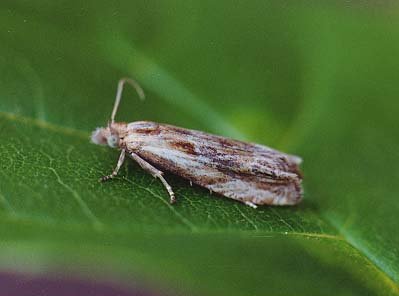49.265 BF1201
Eucosma cana
(Haworth, 1811)
Wingspan 15-23 mm.
Generally common and widely distributed, this species is fairly distinctive with its buffish or greyish ground colour and darker longitudinal streaks. The light longitudinal discal streak on the forewing serves to separate darker specimens with indistinct markings from E. hohenwartiana.
The larvae feed on the flowerheads of various types of thistle (Carduus) and black knapweed (Centaurea nigra).
The adults are on the wing between June and August, and fly from late afternoon onwards, later coming to light.
Larva: (description Ian F. Smith)
Foodplant: August - September in a cavity eaten inside the base of flowerheads/ green seedheads of Cirsium vulgare. October - May in silk hibernaculum in detritus or soil. Old yellowed seedheads may have cavity and frass, but are difficult to open, and usually vacated. Often almost all heads are affected by E. cana. Also in flowerheads/seedheads of Carduus spp. and Centaurea nigra.
Length: 10 mm and 11 mm described.
Head: Burnt ochre. Frons and epicranial lobes thinly edged black. Black postero-lateral mark. Stemmatal area black. Mouthparts dark brown.
Prothoracic shield: Transparent, showing head and body colours. Anterior two thirds tinted brown ochre, with faint greyish brown clouding laterally. A line of fine reddish brown dots separate the anterior two thirds from the posterior, and also run along the edge of the medial line. The posterior third is tinted less intensely. The yellowish white medial line is most distinct at the anterior, where it is edged black. (BTS: "prothoracic plate broad, brown, irregularly spotted with blackish brown laterally and medio-dorsally")
Thoracic legs: Transparent, tinted light brown.
Body: Finely shagreened. Pale terracotta with slight pinkish tint. Paler ventrally.
Spiracles: Peritremes pitchy black.
Pinacula: Small, inconspicuous. Slightly paler than integument, with a very fine brown setal spot.
Setae: Translucent brown.
Anal plate: Anterior third concolorous with abdomen. Remainder slightly paler, with many light brown dots. (BTS: "brown, spotted with blackish")
Prolegs: Yellowish white with a few strong brown crochets.
Similar species: Most Eucosma spp. have very similar larvae. In Centaurea nigra, confusion is possible with E. hohenwartiana.
Deviations mentioned in the above description from BTS may be attributable to instar variation.
Until more is known of Eucosma larvae, it is advisable to rear them to imago to confirm identification. Occupied seedheads should be placed on soil in a netted flower pot in mid/late August, and left outside until the following late May for emergence during June or July.

 UKMoths
UKMoths 








